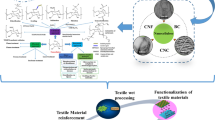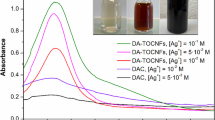Abstract
The aim of research was to fabricate nanohybrid nanopapers based on bacterial cellulose (CNF) and chitosan (CHNF) nanofibers by incorporation of iron oxide (Fe3O4) and aluminum oxide (Al2O3) nanoparticles (NPs). The nanopapers were characterized and their efficiency in selective adsorption of free fatty acids (FFA) from sesame oil was investigated. The oil adsorption capacity and NPs loading capacity of CHNF-based nanopapers were higher than CNF-based ones. The selective adsorption capacity of FFA from sesame oil/oleic acid mixture showed that the nanohybrids are more likely to absorb FFA than to triglycerides and the peroxide value of the oil shows no adverse effect on oxidative deterioration of oil. All nanopapers preserved more than 70% of their activity after 5-stage cycle reusing. Generally, the use of nanopapers as an alternative to chemical neutralization method in the removal of FFA from edible oils can be suggested and the Fe3O4-dopped CHNF nanopaper exhibited the best performance.
Graphical abstract







Similar content being viewed by others
References
Godswill AC, Amagwula IO, Victory IS et al (2018) Effects of repeated deep frying on refractive index and peroxide value of selected vegetable oils. Int J Adv Acad Res 4:106–119
Chew SC, Nyam KL (2020) Refining of edible oils. In: Galanakis CM (ed) Lipids and edible oils. Elsevier, Amsterdam, pp 213–241
Ilgen O (2014) Investigation of reaction parameters, kinetics and mechanism of oleic acid esterification with methanol by using Amberlyst 46 as a catalyst. Fuel Process Technol 124:134–139
Nascimento Pereira MR, Salviano AB, de Medeiros TPV et al (2018) Ca(OH)2 nanoplates supported on activated carbon for the neutralization/removal of free fatty acids during biodiesel production. Fuel 221:469–475
Sathivel S, Prinyawiwatkul W (2004) Adsorption of FFA in crude catfish oil onto chitosan, activated carbon, and activated earth: a kinetics study. J Am Oil Chem Soc 81:493–496
Raval R, Rangnekar RH, Raval K (2017) Materials, energy and environment engineering. Mater Energy Environ Eng. https://doi.org/10.1007/978-981-10-2675-1
Ilgen O, Dulger HS (2016) Removal of oleic acid from sunflower oil on zeolite 13X: kinetics, equilibrium and thermodynamic studies. Ind Crops Prod 81:66–71
Mohamad S, Bakhshaei S, Abdul Manan NS et al (2021) Free fatty acid from waste palm oil functionalized magnetic nanoparticles immobilized on surface graphene oxide as a new adsorbent for simultaneously detecting hazardous polycyclic aromatic hydrocarbons and phthalate esters in food extracts. J Nanosci Nanotechnol 21:5522–5534
Ma Y, Wu Y, Lee JG et al (2020) Adsorption of fatty acid molecules on amine-functionalized silica nanoparticles: surface organization and foam stability. Langmuir 36:3703–3712. https://doi.org/10.1021/acs.langmuir.0c00156
Liu X, Tian J, Li Y et al (2019) Enhanced dyes adsorption from wastewater via Fe3O4 nanoparticles functionalized activated carbon. J Hazard Mater 373:397–407. https://doi.org/10.1016/j.jhazmat.2019.03.103
Zhang J, Feng X, Wang J et al (2020) Nano-crystalline cellulose-coated magnetic nanoparticles for affinity adsorption of glycoproteins. Analyst 145:3407–3413. https://doi.org/10.1039/d0an00442a
Lu Q, Zhang Y, Hu H et al (2019) In situ synthesis of a stable Fe3O4@cellulose nanocomposite for efficient catalytic degradation of methylene blue. Nanomaterials. https://doi.org/10.3390/nano9020275
Cano M, Sbargoud K, Allard E, Larpent C (2012) Magnetic separation of fatty acids with iron oxide nanoparticles and application to extractive deacidification of vegetable oils. Green Chem 14:1786–1795
Hataminia F, Farhadian N (2017) A novel experimental method for adsorption of fatty acids from pumpkin seed oil in the presence of iron oxide nanoparticles: experimental and SA–LOOCV–GRBF mathematical modeling. Colloids Surf A Physicochem Eng Asp 528:30–40. https://doi.org/10.1016/j.colsurfa.2017.05.042
Koju NK, Song X, Wang Q et al (2018) Cadmium removal from simulated groundwater using alumina nanoparticles: behaviors and mechanisms. Environ Pollut 240:255–266. https://doi.org/10.1016/j.envpol.2018.04.107
Chu TPM, Nguyen NT, Vu TL et al (2019) Synthesis, characterization, and modification of alumina nanoparticles for cationic dye removal. Materials (Basel) 12:1–15. https://doi.org/10.3390/ma12030450
Ali S, Abbas Y, Zuhra Z, Butler IS (2019) Correction: Synthesis of γ-alumina (Al2O3) nanoparticles and their potential for use as an adsorbent in the removal of methylene blue dye from industrial wastewater. Nanoscale Adv 1:437–439
Chatterjee S, De S (2014) Adsorptive removal of fluoride by activated alumina doped cellulose acetate phthalate (CAP) mixed matrix membrane. Sep Purif Technol 125:223–238. https://doi.org/10.1016/j.seppur.2014.01.055
de Cademartori PHG, Artner MA, Alves de Freitas R, Magalhães WLE (2019) Alumina nanoparticles as formaldehyde scavenger for urea-formaldehyde resin: rheological and in-situ cure performance. Compos Part B Eng. https://doi.org/10.1016/j.compositesb.2019.107281
Nguyen NT, Dao TH, Truong TT et al (2020) Adsorption characteristic of ciprofloxacin antibiotic onto synthesized alpha alumina nanoparticles with surface modification by polyanion. J Mol Liq 309:113150. https://doi.org/10.1016/j.molliq.2020.113150
Yu H, Liu H, Yuan X et al (2019) Separation of oil–water emulsion and adsorption of Cu(II) on a chitosan–cellulose acetate–TiO2 based membrane. Chemosphere 235:239–247
Zheng M, Wang P-L, Zhao S-W et al (2018) Cellulose nanofiber induced self-assembly of zinc oxide nanoparticles: theoretical and experimental study on interfacial interaction. Carbohydr Polym 195:525–533
Ahmadi A, Ahmadi P, Sani MA et al (2021) Functional biocompatible nanocomposite films consisting of selenium and zinc oxide nanoparticles embedded in gelatin/cellulose nanofiber matrices. Int J Biol Macromol 175:87–97
Mwafy EA, Mostafa AM (2020) Tailored MWCNTs/SnO2 decorated cellulose nanofiber adsorbent for the removal of Cu(II) from waste water. Radiat Phys Chem 177:109172
Janesch J, Jones M, Bacher M et al (2020) Mushroom-derived chitosan-glucan nanopaper filters for the treatment of water. React Funct Polym 146:104428. https://doi.org/10.1016/j.reactfunctpolym.2019.104428
Amjadi S, Emaminia S, Heyat Davudian S et al (2019) Preparation and characterization of gelatin-based nanocomposite containing chitosan nanofiber and ZnO nanoparticles. Carbohydr Polym 216:376–384. https://doi.org/10.1016/j.carbpol.2019.03.062
Mohammadalinejhad S, Almasi H, Esmaiili M (2019) Simultaneous green synthesis and in-situ impregnation of silver nanoparticles into organic nanofibers by Lythrum salicaria extract: morphological, thermal, antimicrobial and release properties. Mater Sci Eng C 105:110115
Almasi H, Jafarzadeh P, Mehryar L (2018) Fabrication of novel nanohybrids by impregnation of CuO nanoparticles into bacterial cellulose and chitosan nanofibers: characterization, antimicrobial and release properties. Carbohydr Polym 186:273–281
Karamipour A, Parsi PK, Zahedi P, Moosavian SMA (2020) Using Fe3O4-coated nanofibers based on cellulose acetate/chitosan for adsorption of Cr(VI), Ni(II) and phenol from aqueous solutions. Int J Biol Macromol 154:1132–1139
Toloue EB, Karbasi S, Salehi H, Rafienia M (2019) Evaluation of mechanical properties and cell viability of poly (3-hydroxybutyrate)-chitosan/Al2O3 nanocomposite scaffold for cartilage tissue engineering. J Med Signals Sens 9:111
Pourreza N, Golmohammadi H, Naghdi T, Yousefi H (2015) Green in-situ synthesized silver nanoparticles embedded in bacterial cellulose nanopaper as a bionanocomposite plasmonic sensor. Biosens Bioelectron 74:353–359. https://doi.org/10.1016/j.bios.2015.06.041
Yang B, Wang L, Zhang M et al (2019) Water-resistant, transparent, uvioresistant cellulose nanofiber (CNF)–aramid nanofiber (ANF) hybrid nanopaper. Mater Lett 240:165–168. https://doi.org/10.1016/j.matlet.2019.01.004
Yang B, Zhang M, Lu Z et al (2019) Comparative study of aramid nanofiber (ANF) and cellulose nanofiber (CNF). Carbohydr Polym 208:372–381
Huang W (2018) Chitin nanopapers. Elsevier, Amsterdam
Fathi N, Almasi H, Pirouzifard MK (2018) Effect of ultraviolet radiation on morphological and physicochemical properties of sesame protein isolate based edible films. Food Hydrocoll 85:136–143. https://doi.org/10.1016/j.foodhyd.2018.07.018
Rozi SKM, Shahabuddin S, Manan NSA et al (2017) Palm fatty acid functionalized Fe3O4 nanoparticles as highly selective oil adsorption material. J Nanosci Nanotechnol 18:3248–3256. https://doi.org/10.1166/jnn.2018.14699
Ahmad AL, Sumathi S, Hameed BH (2005) Adsorption of residue oil from palm oil mill effluent using powder and flake chitosan: equilibrium and kinetic studies. Water Res 39:2483–2494. https://doi.org/10.1016/j.watres.2005.03.035
Aghbashlo M, Mobli H, Madadlou A, Rafiee S (2013) Influence of wall material and inlet drying air temperature on the microencapsulation of fish oil by spray drying. Food Bioprocess Technol 6:1561–1569. https://doi.org/10.1007/s11947-012-0796-7
Mirtalebi SS, Almasi H, Alizadeh Khaledabad M (2019) Physical, morphological, antimicrobial and release properties of novel MgO-bacterial cellulose nanohybrids prepared by in-situ and ex-situ methods. Int J Biol Macromol 128:848–857
Yin R, Yang S, Li Q et al (2020) Flexible conductive Ag nanowire/cellulose nanofibril hybrid nanopaper for strain and temperature sensing applications. Sci Bull 65:899–908. https://doi.org/10.1016/j.scib.2020.02.020
Abral H, Chairani MK, Rizki MD et al (2021) Characterization of compressed bacterial cellulose nanopaper film after exposure to dry and humid conditions. J Mater Res Technol 11:896–904
Sriplai N, Mongkolthanaruk W, Eichhorn SJ, Pinitsoontorn S (2020) Magnetic bacterial cellulose and carbon nanofiber aerogel by simple immersion and pyrolysis. J Mater Sci 55:4113–4126
Mohammadi M, Mirabzadeh S, Shahvalizadeh R, Hamishehkar H (2020) Development of novel active packaging films based on whey protein isolate incorporated with chitosan nanofiber and nano-formulated cinnamon oil. Int J Biol Macromol 149:11–20
Mahdavi S, Jalali M, Afkhami A (2015) Heavy metals removal from aqueous solutions by Al2O3 nanoparticles modified with natural and chemical modifiers. Clean Technol Environ Policy 17:85–102
Yang H, Zhang S, Yan J (2020) Chitosan-reinforced MFC/NFC aerogel and antibacterial property. Adv Polym Technol. https://doi.org/10.1155/2020/7890215
Moussout H, Ahlafi H, Aazza M, Amechrouq A (2018) Al2O3/chitosan nanocomposite: preparation, characterization and kinetic study of its thermal degradation. Thermochim Acta 668:169–177
Zheng Y, Yang J, Zheng W et al (2013) Synthesis of flexible magnetic nanohybrid based on bacterial cellulose under ultrasonic irradiation. Mater Sci Eng C 33:2407–2412. https://doi.org/10.1016/j.msec.2013.02.007
Shahzadi K, Zhang X, Mohsin I et al (2017) Reduced graphene oxide/alumina, a good accelerant for cellulose-based artificial nacre with excellent mechanical, barrier, and conductive properties. ACS Nano 11:5717–5725. https://doi.org/10.1021/acsnano.7b01221
Yu Y, Wang Y, Deng P, Zhang T (2020) Fe3O4@rGO hybrids intercalated nanocellulose-based aerogels for enhanced ferromagnetic and mechanical properties. J Appl Polym Sci 137:48564. https://doi.org/10.1002/app.48564
Nagahama H, Maeda H, Kashiki T et al (2009) Preparation and characterization of novel chitosan/gelatin membranes using chitosan hydrogel. Carbohydr Polym 76:255–260
Beheshti H, Irani M, Hosseini L et al (2016) Removal of Cr (VI) from aqueous solutions using chitosan/MWCNT/Fe3O4 composite nanofibers-batch and column studies. Chem Eng J 284:557–564
Li X, Wang N, Zhang X et al (2020) Optical haze regulation of cellulose nanopaper via morphological tailoring and nano-hybridization of cellulose nanoparticles. Cellulose 27:1315–1326. https://doi.org/10.1007/s10570-019-02876-1
Xiong R, Han Y, Wang Y et al (2014) Flexible, highly transparent and iridescent all-cellulose hybrid nanopaper with enhanced mechanical strength and writable surface. Carbohydr Polym 113:264–271. https://doi.org/10.1016/j.carbpol.2014.06.069
Li L, Iqbal J, Zhu Y et al (2020) Chitosan/Al2O3-HA nanocomposite beads for efficient removal of estradiol and chrysoidin from aqueous solution. Int J Biol Macromol 145:686–693. https://doi.org/10.1016/j.ijbiomac.2019.12.223
Shams MI, Ifuku S, Nogi M et al (2011) Fabrication of optically transparent chitin nanocomposites. Appl Phys A 102:325–331
Yadav M, Rhee KY, Park SJ, Hui D (2014) Mechanical properties of Fe3O4/GO/chitosan composites. Compos Part B Eng 66:89–96
Zhou S, Jiang W, Wang T, Lu Y (2015) Highly hydrophobic, compressible, and magnetic polystyrene/Fe3O4/graphene aerogel composite for oil-water separation. Ind Eng Chem Res 54:5460–5467. https://doi.org/10.1021/acs.iecr.5b00296
Mi HY, Li H, Jing X et al (2020) Superhydrophobic cellulose nanofibril/silica fiber/Fe3O4 nanocomposite aerogel for magnetically driven selective oil absorption. Cellulose 27:8909–8922. https://doi.org/10.1007/s10570-020-03397-y
Hirvikorpi T, Vähä-Nissi M, Harlin A et al (2011) Enhanced water vapor barrier properties for biopolymer films by polyelectrolyte multilayer and atomic layer deposited Al2O3 double-coating. Appl Surf Sci 257:9451–9454. https://doi.org/10.1016/j.apsusc.2011.06.031
Ibrahim S, Wang S, Ang HM (2010) Removal of emulsified oil from oily wastewater using agricultural waste barley straw. Biochem Eng J 49:78–83
Tang J, Song Y, Zhao F et al (2019) Compressible cellulose nanofibril (CNF) based aerogels produced via a bio-inspired strategy for heavy metal ion and dye removal. Carbohydr Polym 208:404–412. https://doi.org/10.1016/j.carbpol.2018.12.079
Jebel FS, Almasi H (2016) Morphological, physical, antimicrobial and release properties of ZnO nanoparticles-loaded bacterial cellulose films. Carbohydr Polym 149:8–19
Acknowledgements
This research did not receive any specific grant from funding agencies in the public, commercial or not-for-profit sectors.
Author information
Authors and Affiliations
Corresponding author
Additional information
Publisher's Note
Springer Nature remains neutral with regard to jurisdictional claims in published maps and institutional affiliations.
Rights and permissions
Springer Nature or its licensor (e.g. a society or other partner) holds exclusive rights to this article under a publishing agreement with the author(s) or other rightsholder(s); author self-archiving of the accepted manuscript version of this article is solely governed by the terms of such publishing agreement and applicable law.
About this article
Cite this article
Javadzadeh, S., Almasi, H., Alizadeh-Khaledabad, M. et al. Immobilization of Al2O3 and Fe3O4 nanoparticles on cellulose and chitosan nanopapers for selective adsorption of free fatty acids from edible oil. Polym. Bull. 81, 2043–2067 (2024). https://doi.org/10.1007/s00289-023-04798-2
Received:
Revised:
Accepted:
Published:
Issue Date:
DOI: https://doi.org/10.1007/s00289-023-04798-2




